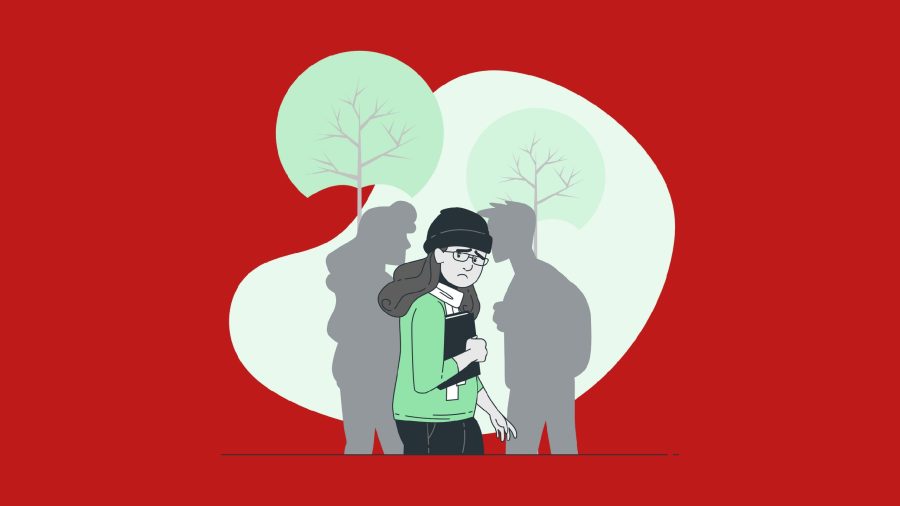OPINION: The reality of living with social anxiety in college
April 20, 2022
Since elementary school, I’ve always been afraid of being judged. I’m always awkward and nervous in social situations. For me, it’s always been that meeting new people or talking to anybody is nerve wracking.
That thought of walking up to somebody random, or even somebody you know, and trying to start a conversation with them is scary.
I never knew what the term was or what it was called growing up, but now I do: social anxiety.
According to the National Institute of Mental Health, social anxiety is an intense fear of being watched and judged by others.
Most think social anxiety is the fear of being watched or being shy but it’s much more. There is so much that comes along with social anxiety.
People who have social anxiety have a major fear or anxiety over what people think can be the simplest things like speaking in public, meeting new people, dating, answering or speaking in class, talking to a cashier in a store and lots more. It’s little things like those that give me severe anxiety and fear.
One thing that’s common for people with social anxiety is that their fear is so extreme that they feel it’s beyond their control.
Fear gets in the way of doing everyday tasks like going to class and work, going to a restaurant or ordering from a fast food place, going out in public and other simple tasks that seem like chores.
Everyday interactions or tasks cause significant anxiety, self consciousness and embarrassment because you feel like you’re being judged negatively or highly scrutinized.
Social anxiety isn’t just another disorder. Social anxiety can wreak havoc or take over someone’s life. It takes control of you and you think there’s no way out.
There can be many possible causes. Social anxiety and anxiety traits can be inherited. They tend to run in families. But, it isn’t always entirely clear how much of this may be due to genetics and learned behavior.
Another possible cause could be because of the brain structure. The amygdala is a mass inside the cerebral hemisphere of the brain and it’s involved with the experiencing of emotions.
People who have an overactive amygdala may have heightened fear response, increasing anxiety in certain situations and interactions.
A certain environment could also be another possible cause. Some people may develop significant anxiety after an unpleasant or embarrassing social situation.
There may be a link between social anxiety and parents who either model anxious behavior in social situations or are more controlling or overprotective of their children.
There are several risk factors that can increase the development of social anxiety. Family history is one. A person is more likely to have social anxiety if their biological parents or siblings have it.
Having a physical trait that draws attention to yourself is also a risk factor. A physical disfigurement, stuttering, tremors, disabilities or diseases can increase a person’s self-consciousness and make them likely to develop social anxiety.
One of the main risk factors to developing social anxiety is having a history of negative experiences.
People who experience rejection, bullying, teasing or ridicule as children are more prone to social anxiety. Other negative events in life such as family drama and conflict, trauma or abuse can also contribute to having social anxiety.
Personally, there were different things that contributed to my social anxiety. One of the main reasons though is my disability. I was born with a detached retina in my right eye, meaning my retina is lifted and detached, making my vision blurry.
Even though I had surgeries afterwards, nothing could’ve been done and if your detached retina isn’t treated right away or soon, you could lose vision in that eye, which is what happened to me.
Being blind in one eye and having a physical disability, I was subjected to bullying, teasing, abuse and rejection growing up. From elementary to middle school.
I was very self conscious, shy and anxious. It wasn’t until in the middle of elementary school where I developed the many fears that come along with social anxiety.
I used to not talk at all besides the few friends I had. I sometimes ate by myself during breakfast or lunch. I dreaded speaking to new people or partnering with them on any project or game in school.
I hated being called on in class because it gave me so much anxiety with all the attention drawn to me. I hated speaking up because of my fear of rejection or ridicule.
Most of that carried over into middle and high school. But as the shyness and self consciousness faded a bit, my anxiety and fear only grew.
The fear of meeting and talking to new people grew. The fear of being bullied or picked on because of how I look or act grew. The fear of being called on or being the center of attention grew.
Nearing the end of high school, my social anxiety got a bit better. I still have it, but it’s not as bad as before.
There are some things I do that help with my social anxiety. Listening to music is a big one. When I’m out in public or at a gathering or event of some sort, I listen to music to soothe my anxiety because music is one of the main things that calms me.
I also get on my phone, whether I’m playing a game or scrolling through social media. Detaching from social situations at a good time and focusing on something else like your phone, at least for me, is a good way to relieve stress and social anxiety.
Social anxiety can’t be cured, but there are treatments that can help manage it. Medical providers may recommend therapy or medication.
There are many types of therapy and psychotherapy but cognitive behavior therapy is the only type of therapy that shows effectiveness.
The goal of CBT is to help people learn techniques to change the way they behave in situations that cause social anxiety.
The most common type of CBT is exposure therapy, which involves exposing people to situations they are afraid of and helping them manage the fear. It also teaches them relaxation techniques and social skills.
About 50 to 66% of people with social anxiety reported improvements in symptoms in about 12 weeks, according to Harvard Medical School.
Another treatment can be medications. Medications for social anxiety can include antidepressants, anti-anxiety medications and beta-blockers.
If you think you might have social anxiety or social anxiety disorder (SAD), consult with your doctor about it and see what a medical professional has to say about it. Therapy is also helpful.
Having social anxiety may seem like the end of the world, or that it’s too much to handle or bare. I feel that way most times too. But try to remember that it does and can get better and there are ways and steps you can take to help overcome it!
Commentary writer DJ Stover can be reached at [email protected]. Follow him on Twitter @DeJayeJJ.






















